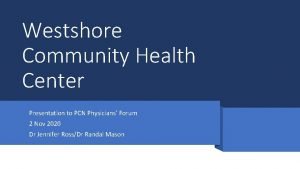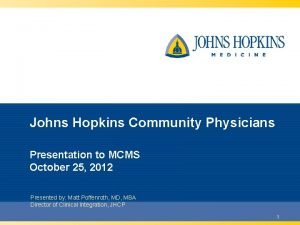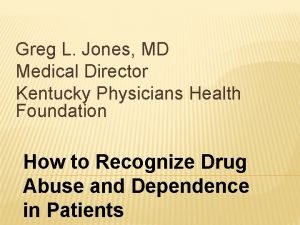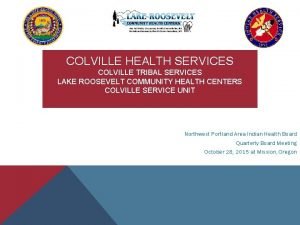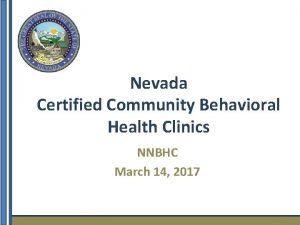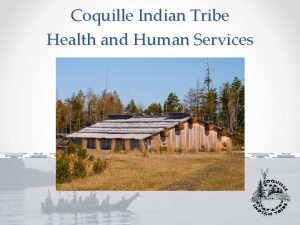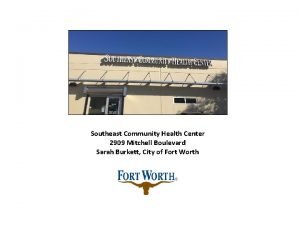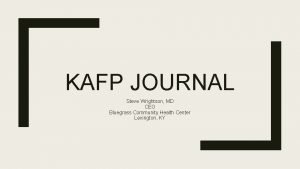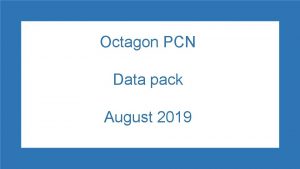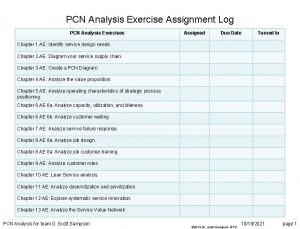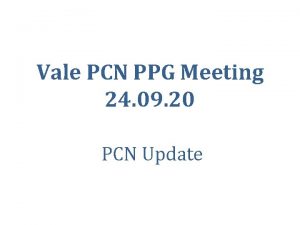Westshore Community Health Center Presentation to PCN Physicians












- Slides: 12

Westshore Community Health Center Presentation to PCN Physicians’ Forum 2 Nov 2020 Dr Jennifer Ross/Dr Randal Mason

CHCs • Are multi-sector not for profit organizations providing a population with primary care, including services to support the social determinants of health • Provide team based interdisciplinary primary care • Integrate diverse health and social services • Community-centered and patient-focused • Demonstrate a commitment to health equity, cultural safety and humility, and social justice

Community need • Attachment gap (2016): 36475 • Attachment gap (2023 projected): 65064 • Unattachment rates range 31 -39% of the population • Most prevalent conditions: • HTN, asthma, anxiety/depression, OA and DM • Attachment worst for people with chronic conditions and MHSU

Partner organizations Providing mental health and community services in the Westshore since 1968 Providing low barrier, trauma informed, teambased care for people living with substance use disorders, in the Westshore, since 2017

CHC planning committee • PCFSA • AVI • BCACHC • Patient partners • Meeting bi-weekly since April 2020

Priority populations • Priority populations for the Westshore Community Health Centre will be individuals of all ages and their families who experience barriers to health/health care due to the impact of inequity and the Social Determinants of Health which include: income, employment and working conditions, education/literacy, childhood experiences, built environment, lack of social supports, colonization, gender/race/class based discrimination and the intersection of same. Groups that typically experience these impacts disproportionately in the Westshore include: • People with moderate to severe mental health conditions • People with substance use disorders • Seniors • People with multiple chronic health conditions • People who identify as Indigenous • Gender diverse/LGBTQ 2 S people

Service delivery model – primary care team • Longitudinal, relationship-based care • Low barrier/trauma informed FP/NP CHW Patient and family MOA RN • Extended hours (8 -8, weekends) • Leverage virtual care • Outreach team M-F

Clinic wide resources/PCN shared MH Counsellors PCN Social work Primary care team and patient PCN pharmacist AVI team • Leverage PCFSA existing mental health infrastructure • Leverage AVI addiction medicine and team-based care expertise • Co-locate with PCN SW and pharmacist

PCN attachment gap - total CHC attachment target 36475 7788 CHC attachment as % of total PCN attachment gap 21%

Hub and Spoke • PCFSA building in Colwood • Second floor

Centrally located

 Westshore chc
Westshore chc Westshore junior senior high school
Westshore junior senior high school John hopkins community physicians
John hopkins community physicians Maryland physician health program
Maryland physician health program Greg jones md
Greg jones md Colville indian health center
Colville indian health center List of certified community behavioral health clinics
List of certified community behavioral health clinics Coquille indian tribe community health center
Coquille indian tribe community health center Southeast community health center
Southeast community health center Bluegrass community health center
Bluegrass community health center Role and responsibility of occupational health nurse
Role and responsibility of occupational health nurse Arc pcn bucks
Arc pcn bucks Pcn wifi staff
Pcn wifi staff
